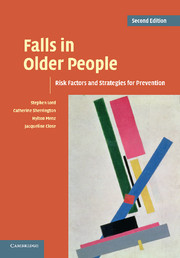Part II - Strategies for prevention
Published online by Cambridge University Press: 03 May 2010
Summary
Falls prevention – an overview
The first section of this book provides detailed evidence on the physiological mechanisms integral to human balance and gait as well as describing in depth the factors that have been found to increase falls risk. While some of the identified risk factors are irreversible, there are many which are potentially modifiable or remediable with appropriate interventions. The irreversible factors are useful for identifying high-risk populations for targeted interventions, whilst the identification of modifiable risk factors provides a platform for focused interventions aimed at reducing falls risk. Heterogeneity is a major feature of the risk factor literature. This indicates that no single approach to prevention will adequately address the problem of falls and injury in older people.
Table 10.0 highlights the risk factors identified in Part I of this book that are most consistently associated with an increased falls risk, and suggests potential strategies for reducing or reversing such risks where possible.
This second part of the book concentrates on evidence-based assessments and interventions to prevent falls, and describes several different approaches applied to a range of at-risk populations. Exercise has been the most thoroughly investigated single intervention, and there is now a strong evidence base to support specific types of exercise for modifying falls risk factors and preventing falls. These findings are discussed in detail in Chapters 10 and 11.
- Type
- Chapter
- Information
- Falls in Older PeopleRisk Factors and Strategies for Prevention, pp. 173 - 176Publisher: Cambridge University PressPrint publication year: 2007
- 2
- Cited by

